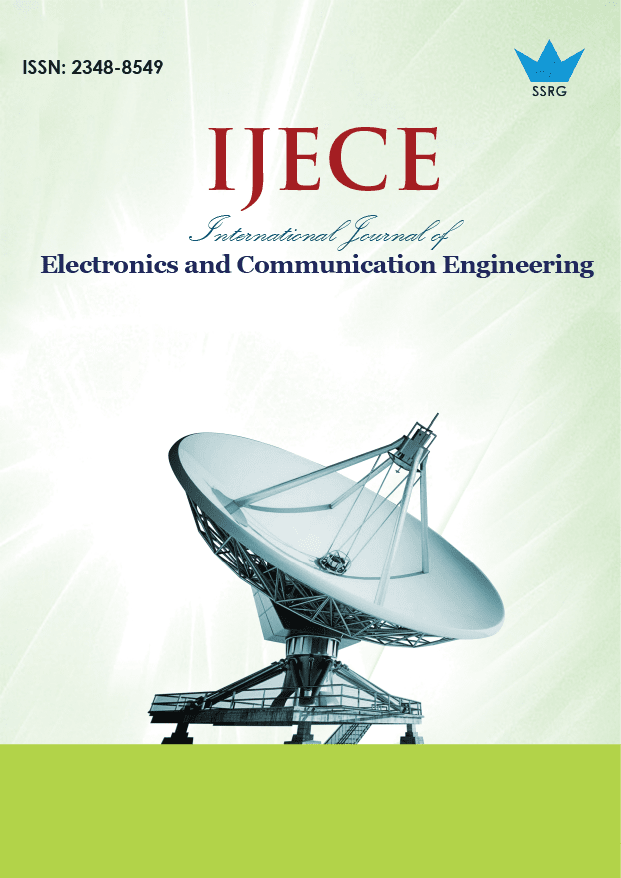Optimizing Nanowire Dimensions for Enhanced Performance in Biosensing Platforms for Early Detection of Dengue

| International Journal of Electronics and Communication Engineering |
| © 2025 by SSRG - IJECE Journal |
| Volume 12 Issue 8 |
| Year of Publication : 2025 |
| Authors : Tulasi Radhika Patnala, Madhavi Tatineni |
How to Cite?
Tulasi Radhika Patnala, Madhavi Tatineni, "Optimizing Nanowire Dimensions for Enhanced Performance in Biosensing Platforms for Early Detection of Dengue," SSRG International Journal of Electronics and Communication Engineering, vol. 12, no. 8, pp. 161-167, 2025. Crossref, https://doi.org/10.14445/23488549/IJECE-V12I8P114
Abstract:
Because of their exceptional mechanical, optical, and electrical characteristics, Nanowires (NWs) have become important parts of biosensing platforms. Early identification is the key to containing epidemics and lowering morbidity caused by the Dengue Virus (DENV). The label-free, real-time detection capabilities of biosensors based on Nanowires (NW) are made possible by their programmable electrical characteristics and huge surface-to-volume ratios. In this study, we look at how the length and width of nanowires affect the effectiveness of biosensors designed to detect the dengue virus NS1 antigen early on. Using a combination of simulation and experimental validation, we identify the optimal NW configuration that maximizes sensitivity, lowers the Limit of Detection (LOD), and ensures practical integration for point-of-care diagnostics.
Keywords:
Nanowire, Limit of detection, Biosensing, Dengue virus.
References:
[1] Fernando Patolsky, Gengfeng Zheng, and Charles M. Liebe, “Nanowire-based Biosensors,” American Chemical Society, pp. 4261-4269, 2006.
[Google Scholar] [Publisher Link]
[2] Sumit Malik et al., “Nanomaterials-based Biosensor and their Applications: A Review,” Heliyon, vol. 9, no. 9, pp. 1-24, 2023.
[CrossRef] [Google Scholar] [Publisher Link]
[3] Mansi Chaturvedi et al., “Bio-Inspired Graphene Nanocomposite Enabled Electrochemical Immunosensor for Detection and Quantification of NS1 Protein of Dengue Virus,” Electrochimica Acta, vol. 475, 2024.
[CrossRef] [Google Scholar] [Publisher Link]
[4] Vy Anh Tran et al., “Recent Applications and Prospects of Nanowire-Based Biosensors,” Processes, vol. 11, no. 6, pp. 1-23, 2023.
[CrossRef] [Google Scholar] [Publisher Link]
[5] Pareesa Pormrungruang et al., “Metal Oxide Nanostructures Enhanced Microfluidic Platform for Efficient and Sensitive Immunofluorescence Detection of Dengue Virus,” Nanomaterials, vol. 13, no. 21, pp. 1-15, 2023.
[CrossRef] [Google Scholar] [Publisher Link]
[6] Vinitha Mariyappan et al., “Mo-W-O Nanowire Intercalated Graphene Aerogel Nanocomposite for the Simultaneous Determination of Dopamine and Tyrosine in Human Urine and Blood Serum Sample,” Journal of Electroanalytical Chemistry, vol. 895, 2021.
[CrossRef] [Google Scholar] [Publisher Link]
[7] Vy Anh Tran et al., “Application Prospects of MXenes Materials Modifications for Sensors,” Micromachines, vol. 14, no. 2, pp. 1-25, 2023.
[CrossRef] [Google Scholar] [Publisher Link]
[8] Vy Anh Tran et al., “Metal–Organic Frameworks-Derived Material for Electrochemical Biosensors: Recent Applications and Prospects,” Industrial & Engineering Chemistry Research, vol. 62, pp. 4738-4753, 2023.
[CrossRef] [Google Scholar] [Publisher Link]
[9] Ren Liu et al., “Ultra-Sharp Nanowire Arrays Natively Permeate, Record, and Stimulate Intracellular Activity in Neuronal and Cardiac Networks,” Advanced Functional Materials, vol. 32, no. 8, pp. 1-40, 2022.
[CrossRef] [Google Scholar] [Publisher Link]
[10] Biswajoy Bagchi et al., “Copper Nanowire Embedded Hypromellose: An Antibacterial Nanocomposite Film,” Journal of Colloid and Interface Science, vol. 608, pp. 30-39, 2022.
[CrossRef] [Google Scholar] [Publisher Link]
[11] Leonardo Fanton et al., “Proliferation of Osteoblast Precursor Cells on the Surface of TiO2 Nanowires Anodically Grown on a β-type Biomedical Titanium Alloy,” Scientific Reports, vol. 12, pp. 1-14, 2022.
[CrossRef] [Google Scholar] [Publisher Link]
[12] Dongsheng Liu et al., “Growth of uniform CuCo2O4 Porous Nanosheets and Nanowires for High-Performance Hybrid Supercapacitors,” Journal of Energy Storage, vol. 52, 2022.
[CrossRef] [Google Scholar] [Publisher Link]
[13] Ajeng Prameswati et al., “Highly Stretchable and Mechanically Robust Silver Nanowires on Surface-Functionalized Wavy Elastomers for Wearable Healthcare Electronics,” Organic Electronics, vol. 108, pp. 1-12, 2022.
[CrossRef] [Google Scholar] [Publisher Link]
[14] Jaehyo Jung, Siho Shin, and Youn Tae Kim, “Dry Electrode Made from Carbon Nanotubes for Continuous Recording of Bio-Signals,” Microelectronic Engineering, vol. 203-204, pp. 25-30, 2019.
[CrossRef] [Google Scholar] [Publisher Link]
[15] Sakshum Khanna et al., “Controlled Restructuring of Bidisperse Silica Nanospheres for Size-Selective Nanowire Growth,” Materials Chemistry and Physics, vol. 273, 2021.
[CrossRef] [Google Scholar] [Publisher Link]
[16] Ting-Yuan Chang et al., “Orientation-Controlled Selective-Area Epitaxy of III–V Nanowires on (001) Silicon for Silicon Photonics,” Advanced Functional Materials, vol. 30, no. 30, pp. 1-25, 2020.
[CrossRef] [Google Scholar] [Publisher Link]
[17] Vy Anh Tran et al., “Utilization of Functionalized Metal–Organic Framework Nanoparticle as Targeted Drug Delivery System for Cancer Therapy,” Pharmaceutics, vol. 15, no. 3. pp. 1-30, 2023.
[CrossRef] [Google Scholar] [Publisher Link]
[18] Vy Anh Tran et al., “Dual Stimuli-Responsive Multifunctional Silicon Nanocarriers for Specifically Targeting Mitochondria in Human Cancer Cells,” Pharmaceutics, vol. 14, no. 4, pp. 1-19, 2022.
[CrossRef] [Google Scholar] [Publisher Link]

 10.14445/23488549/IJECE-V12I8P114
10.14445/23488549/IJECE-V12I8P114